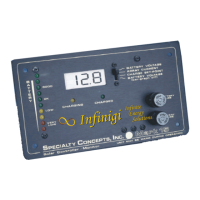RELATED SYSTEM EQUIPMENT
The MARK/(15,20) is an integral part of a solar electric power system that includes a
solar panel, a battery and a load.
SOLAR PANELS - (“photovoltaic (PV) array”, “solar modules”):
The MARK/(15,20) is compatible with all makes and models of photovoltaic solar
panels.
The entire solar array’s open circuit voltage (Voc) cannot exceed 26 volts (the sum of
the Voc of all solar panels in series). Also, the solar array’s short circuit current (Isc)
cannot exceed 15 amps (for MARK/15) or 20 amps (for MARK/20). (This is the sum of
the short circuit currents (Isc) of all the solar panels in parallel). Remember that cold
temperatures increase the charging current from the panels. Refer to the solar panel’s
specifications for the temperature chart.
Install all panels with the correct series-parallel configuration to insure proper system
voltage (12 volts) and current.
The MARK/(15,20) includes a blocking diode to eliminate leakage of the battery power
into the solar panels at night. No additional protection is needed.
OTHER CHARGING SOURCES: Systems with an additional source of charging
(alternator, battery charger, etc.) can operate with a solar array and a MARK/(15,20). All
charging sources need to connect directly to the battery on independent lines and have
their own form of over-charge protection.
MARK/(15,20) FOR NON-SOLAR APPLICATIONS: These units will only operate with
solar electric panels. Do not use to regulate other power sources, such as a hydro or
wind generators/alternators or AC battery chargers. These charging sources can
damage the controller and/or the generating equipment because the MARK/(15,20)
stops charging by short circuiting the input.
BATTERIES: The MARK/(15,20) provides the proper charging of standard lead-acid
batteries that are normally used in recreational vehicles, boats, and remote stand alone
systems. These include wet cell batteries (with filler caps), sealed, maintenance-free and
gel-cell batteries. Automobile batteries can also be charged, but these batteries are
rarely used as the primary battery in a solar system. Install all batteries with the correct
series-parallel configuration to insure proper system voltage and current.
SYSTEMS WITH TWO BATTERY BANKS: When solar charging two separate battery
banks, a switch can be installed to allow manual selection of one battery or the other.
BATTERY ISOLATORS: In installations that use a diode battery isolator with two
batteries, the MARK/(15,20) needs to connect directly to one of the batteries or an
output from the isolator. The MARK/(15,20) will not operate if it is connected to the input
of the isolator.
LOADS: System loads such as lights, radios and DC/AC inverters must be 12 volts DC
(unless an inverter is being used).
3

